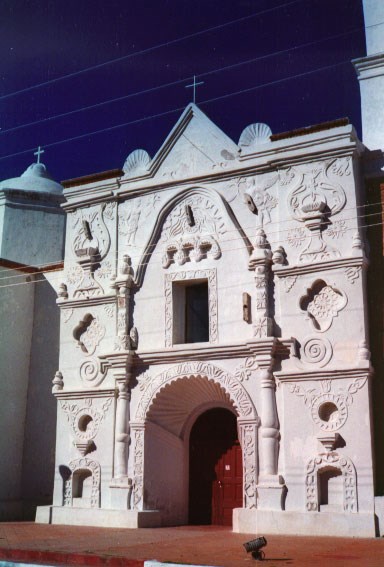
"Because this was the headquarters of religious administration for the entire Pimería Alta during much of the Jesuit and Franciscan periods, it can be argued that after 1732, at least, it was also the most important church, the very hub of Pimería Alta mission activities. Established by the Jesuits in 1691, the first mission building at Tubutama may have been destroyed in the Pima uprising of 1695. A second adobe church was completed in 1699 and a third may have been finished in 1706. Construction on a successor had been started in 1730 and a fifth, built of more than fifty thousand adobes, was underway in 1747 only to be destroyed in the Pima revolt of 1751. "While the 1751 rebellion had reduced Jesuit missionary Jacobo Sedelmayr's house of worship to ashes, Father Luis Vivas, his successor in 1753, was able to build a new adobe church by 1764, one with two altars, a small side chapel, and a sacristy. The first Franciscan to reside there in 1768 begged that the civil commissioner give him some old cloaks and pieces of heavy Chinese linen left by the Jesuits so he could cover the windows of the building to keep out the bats." (The Pimeria Alta: Southwestern Mission Research Center) Bishop Antonio de los Reyes on 6 July 1772 wrote a report on the condition of the missions in the Upper and Lower Pimeria. Following is his report on Tubutama as translated by Father Kieran McCarty:
"In the second half of the 1770s the Franciscans went to work to build a more substantial temple for Tubutama. In 1793, reporting from his mission station at Aconchi on the Sonora River, Father Antonio Barbastro, who served at Tubutama from 1776 to 1783, reminisced 'I was able to build a church some eighty-two feet long and over sixteen feet wide, with a transept, a dome-shaped cupola above, and a famous facade. From the foundations everything was brick and lime plaster. On dedication day (in 1783) we featured eleven statues and a (liturgical) lamp of silver.' Barbastro's successor, Francisco Yturralde, who remained at Tubutama until 1799, also had a hand in the building's construction. Both physical evidence and documentary records suggest that the baptistry, with its mudéjar arched entrance, was an Yturralde addition made before 1796." "Tubutama was perhaps the first settlement in the Pimería Alta laid out as a fortified town with the houses built into ramparts and their doors opening onto the plaza. The walls had only two narrow gates which were closed from sundown to sunrise to protect the people and oxen enclosed inside at night." "The interior of Tubutama's church is especially noteworthy for a transept dedicated to the Passion of Christ and which has sculptured in plaster in bas-relief on its altarpiece instruments of the Passion: crown of thorns, scourge, nails, tongs, ladder, and lances. A sculptured serpent crawls beneath an upper niche in the same altarpiece. This recess now holds a carved statue of Our Lady of Aránzazu, an image of the Virgin Mary as she appeared at Aránzazu in the Basque country of northern Spain. Another unusual decorative element in Tubutama is the carved wooden pomegranates pendant from the ceiling beneath the choir loft. Visitors are charmed by the bas-relief sculptures on the building's facade. Not only is there a sun dial there, but there are also a pair of angels, each carrying a rooster - one of the emblems of Saint Peter.” (The Pimería Alta: Southwestern Mission Research Center) |
Last updated: May 6, 2025
